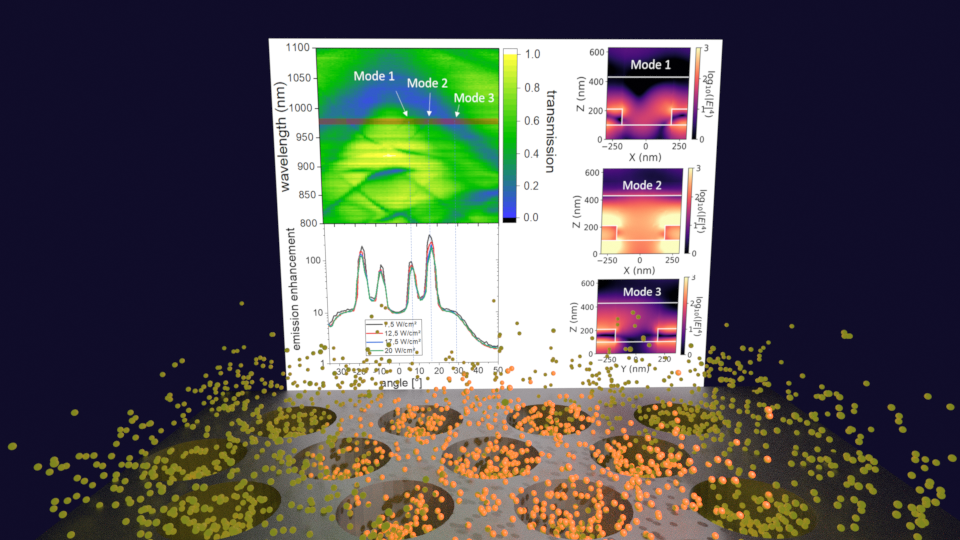
Sketch of a metasurface and nanoparticles. The data shows the correlation of transmission and emission enhancement and the resulting distribution of the electric field.
Source: BAM, division Biophotonics
Upconverting nanocrystals (UCNPs) form a comparably new class of rare earth-based luminescent nanomaterials with optical properties that are favorable for applications like reporters for fluorescence assays, sensors and imaging applications in the life sciences and high-resolution microscopy, photodynamic therapies in medicine, optogenetics, photovoltaics (increasing the efficiency of solar cells), optical data storage, lasers and security barcodes. Upconversion is a multiphotonic process which includes the sequential absorption of longer wavelength photons by long-lived metastable energy states. This implies that two or more photons in the invisible, near-infrared spectral range are absorbed by the nanoparticles, upconverted to higher energies and subsequently, one photon of higher energy (with a shorter wavelength) is emitted. Such an upconversion process can occur in crystalline hosts doped with e.g. Er3+ or ion pairs such as Yb3+ / Er3+. Here the Yb3+ ions serve as sensitizers that absorb near infrared (NIR) photons and transfer their energy to neighboring Er3+ ions, where the actual upconversion process occurs. The upconversion process is non-linear, which means that the more photons hit the material per time the more efficient is the upconversion process – and thus the upconversion luminescence and its quantum yield depend on excitation power density. Here the metasurfaces come into the game.
Metasurfaces (often also called photonic crystals) are made up by periodically arranged holes or rods. These structures are optically active. If light is not understood as a particle but as a wave, the interaction of a light wave with the periodic surface can be modeled. Some light waves can couple from free space to the metasurface. These are so-called “leaky mode” because they can couple to the metasurface from free space. Leaky modes cause a strong field energy enhancement close to the surface which can be used to excite the nanoparticles and make the upconversion process more efficient. By combining a properly designed nano-imprinted metasurface with upconversion nanoparticles an emission enhancement of up to 1000 was observed. Using well characterized upconversion nanoparticles, the non-linear upconversion luminescence can be utilized to measure the field energy near the metasurface, thus using these particles as electric field nanosensors. This can be exploited to measure the field energy in the immediate neighborhood of the metasurface and to validate theoretical models. Since the increase in field energy reaches only a few 100 nm from the metasurface, no verification of the theory was possible so far.
Metasurface Enhanced Sensitized Photon Upconversion: Toward Highly Efficient Low Power Upconversion Applications and Nanoscale E-Field Sensors
Christian Würth, P. Manley, R. Voigt, D. Ahiboz, C. Becker, Ute Resch-Genger Saliwan‑Neumann, Alexander Evans, Giovanni Bruno
published in Nano Letters, Vol. 10, issue 9, pages 6682 - 6689, 2020
BAM, division Biophotonics


